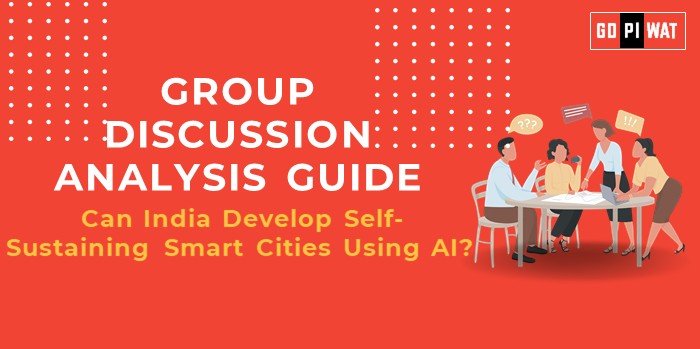📋 Group Discussion Analysis Guide: Can India Develop Self-Sustaining Smart Cities Using AI?
🌐 Introduction
India’s ambitious Smart Cities Mission, launched in 2015, envisions creating 100 urban centers that are citizen-friendly, sustainable, and technologically advanced. With AI projected to become a $17 billion industry by 2027, the integration of AI into smart cities could revolutionize urban living by enhancing efficiency, sustainability, and governance.
📊 Quick Facts and Key Statistics
• Smart Cities Mission: Launched in 2015 to develop 100 cities integrating sustainability and technology.
• AI Market Growth: Projected to reach $17 billion by 2027, growing at a CAGR of 25-35%.
• Urban Population: 519 million (2023), growing at 2.19% annually.
• New Projects: ₹28,602 crore allocated in 2024 for 12 industrial smart cities under the National Industrial Corridor Development Programme.
• AI Market Growth: Projected to reach $17 billion by 2027, growing at a CAGR of 25-35%.
• Urban Population: 519 million (2023), growing at 2.19% annually.
• New Projects: ₹28,602 crore allocated in 2024 for 12 industrial smart cities under the National Industrial Corridor Development Programme.
🌟 Stakeholders and Their Roles
- 🏛️ Government: Leads planning, funding, and execution of the Smart Cities Mission.
- 💼 Private Sector: Provides AI technologies, IoT solutions, and infrastructure.
- 👥 Citizens: Drive the success of smart services through adoption and feedback.
- 🌐 Global Collaborators: Offer expertise in AI implementation and benchmarking, such as insights from Singapore and Estonia.
🏆 Achievements and Challenges
📌 Achievements:
- ✅ Improved Governance: Cities like Pune have digitized 80% of services, ensuring efficient service delivery.
- ✅ AI in Resource Management: Indore’s AI-enabled waste collection improved efficiency by 40%.
- ✅ Industrial Growth: New smart city projects approved in 2024 showcase industrial and infrastructural expansion.
📌 Challenges:
- ⚠️ Urban-Rural Gap: AI adoption remains limited in smaller towns and rural areas.
- ⚠️ Cybersecurity Concerns: Increasing reliance on AI heightens risks, as seen in the 2022 AIIMS cyberattack.
- ⚠️ Financial Sustainability: High investments in technology require long-term planning to ensure ROI.
🎯 Effective Discussion Approaches
- Opening Approaches:
- Fact-Based: “With a $17 billion AI market by 2027, India stands at the forefront of leveraging AI for sustainable urban development.”
- Global Comparison: “India can emulate Singapore’s Smart Nation program to bridge gaps in its Smart Cities Mission.”
- Counter-Argument Handling:
- Rebuttal: “While initial investments are high, the long-term cost savings from AI-powered solutions make them viable.”
📈 Strategic Analysis of Strengths and Weaknesses
- Strengths: Strong government push, established technology ecosystem.
- Weaknesses: Limited rural reach, cybersecurity vulnerabilities.
- Opportunities: Growth of the AI industry, increased global collaborations.
- Threats: Digital divide, privacy concerns.
🗣️ Structured Arguments for Discussion
- 👍 Supporting Stance: “India’s integration of AI in smart cities has demonstrated clear successes, such as Indore’s waste management system.”
- 👎 Opposing Stance: “AI’s benefits are constrained by digital divides and cybersecurity risks, especially in underdeveloped regions.”
- ⚖️ Balanced Perspective: “While AI has transformative potential for Indian smart cities, addressing inclusivity and security challenges is essential for success.”
🎓 Connecting with B-School Applications
- 📌 Real-World Applications:
- Exploring the role of AI in urban finance and governance.
- Researching the ROI of AI-powered smart city solutions.
- ❓ Sample Questions:
- “How can India overcome the digital divide to ensure smart city inclusivity?”
- “What lessons can India draw from global smart city models like Singapore or Estonia?”


